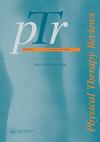结构化运动项目在多囊卵巢综合征中的作用:一项系统综述
IF 0.8
Q4 REHABILITATION
引用次数: 0
摘要
摘要背景多囊卵巢综合征(PCOS)是一种内分泌紊乱,影响10%的育龄妇女。几种药物和非药物干预措施用于治疗多囊卵巢综合征妇女的症状。目的本综述的目的是确定和讨论结构化运动计划对多囊卵巢综合征相关临床特征和生物标志物的益处的证据。方法利用PCOS的关键概念,通过系统检索PubMed、Cochrane Library和CINAHL,确定2000年至2019年间发表的潜在研究。PEDro量表用于评估研究的证据强度。结果鉴定出13篇质量中等至较强的手稿。所有研究都涉及从8岁开始的结构化锻炼制度 至24周 周持续时间,频率可变(每周2-5次),持续时间可变(25-60 分钟)。大多数研究报告月经周期、Ferriman-Gallwey评分、睾酮、DHEA-S、性激素结合球蛋白水平和游离雄激素指数评分有所改善。结论结构明确的有氧和阻力训练方案,独立或与饮食控制相结合,至少持续12个月 数周后,与多囊卵巢综合征相关的许多临床参数和生物标志物有所改善。本文章由计算机程序翻译,如有差异,请以英文原文为准。
Role of structured exercise programs in polycystic ovary syndrome: a systematic review
Abstract Background Polycystic Ovary Syndrome (PCOS) is an endocrine disorder affecting up to 10% of women of reproductive age. Several pharmacological and non-pharmacological interventions are used to manage symptoms in women with PCOS. Objective The objective of this review was to identify and discuss evidence pertaining specifically to the benefits of structured exercise programs on clinical features and biomarkers relevant to PCOS. Methods Potential studies published between 2000 and 2019 were identified by systematically searching PubMed, Cochrane Library, and CINAHL by using key concepts of PCOS. The PEDro scale was used to evaluate studies’ strength of evidence. Result Thirteen manuscripts of moderate to strong quality were identified. All studies involved structured exercise regimes lasting from 8 weeks to 24 weeks duration with variable frequency (2–5 sessions per week) and duration (25–60 min). Most of the studies reported improvements in menstrual cyclicity, Ferriman-Gallwey scores, testosterone, DHEA-S, sex hormone binding globulin levels and free androgen index scores. Conclusion Structured well-defined aerobic and resistance training protocols, independently or in combination with diet control, that lasted for at least 12 weeks led to improvements in a number of clinical parameters and biomarkers related to PCOS.
求助全文
通过发布文献求助,成功后即可免费获取论文全文。
去求助
来源期刊

Physical Therapy Reviews
REHABILITATION-
CiteScore
1.30
自引率
0.00%
发文量
26
期刊介绍:
Physical Therapy Reviews is an international journal which aims to publish contemporary reviews, discussion papers and editorials within physical therapy, and in those basic and clinical sciences which are the basis of physical therapy. The journal is aimed at all those involved in research, teaching and practice within the area of physical therapy. Reviews (both descriptive and systematic) are invited in the following areas, which reflect the breadth and diversity of practice within physical therapy: •neurological rehabilitation •movement and exercise •orthopaedics and rheumatology •manual therapy and massage •sports medicine •measurement •chest physiotherapy •electrotherapeutics •obstetrics and gynaecology •complementary therapies •professional issues •musculoskeletal rehabilitation
 求助内容:
求助内容: 应助结果提醒方式:
应助结果提醒方式:


